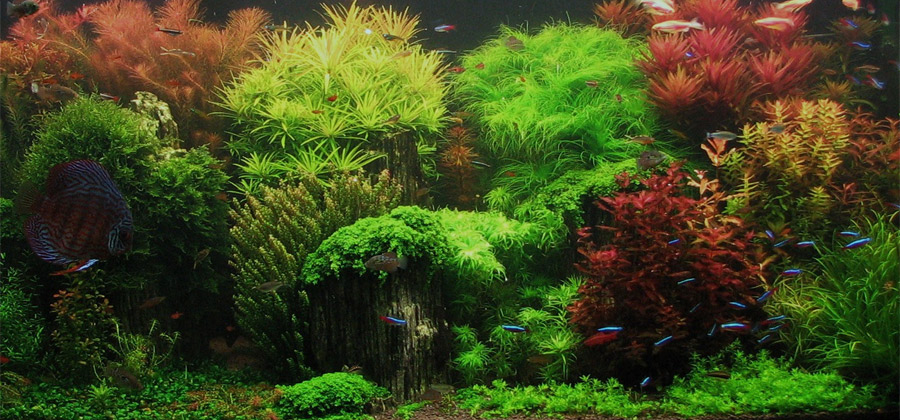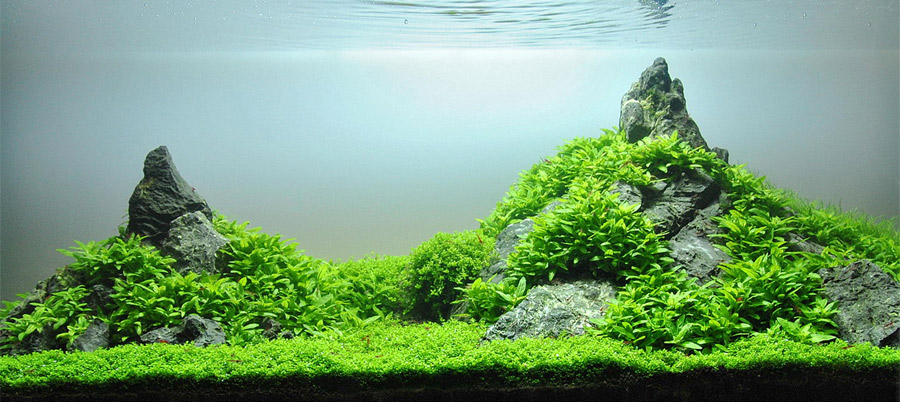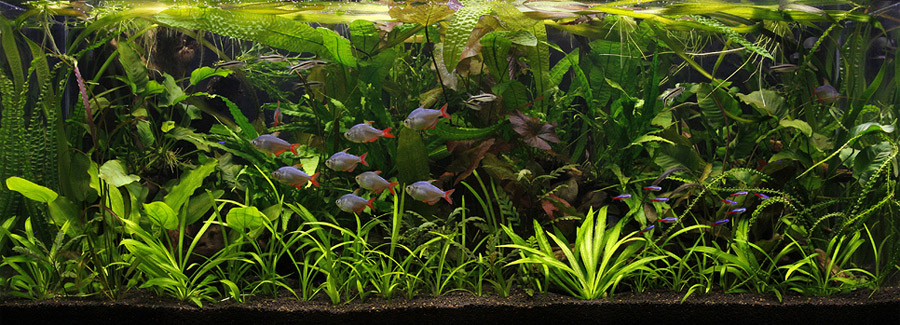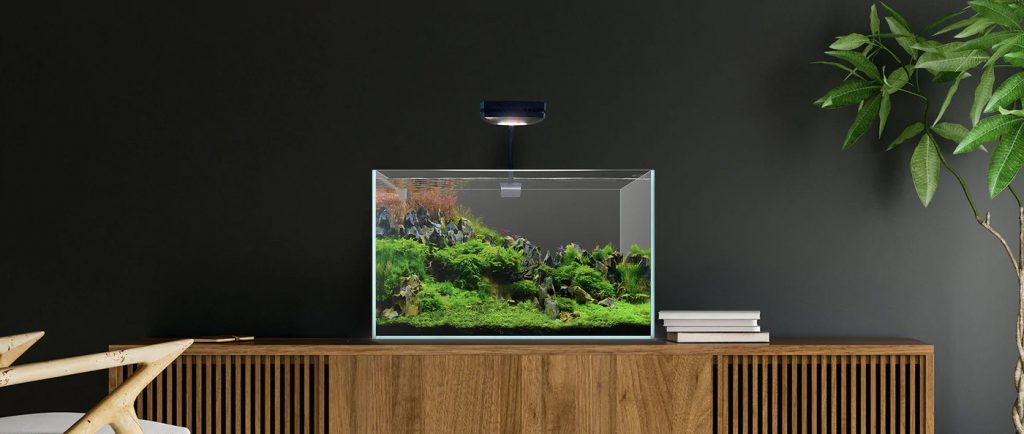What is aquascaping?
Aquascaping is the art of arranging aquarium plants, rocks, driftwood, and other pieces of hardscape in an aesthetically pleasing manner. In essence, it’s gardening underwater. Popular aquascaping options include garden-like Dutch and Japanese-inspired nature styles.
Aquascaping styles
Any aquascape aims to create a beautiful underwater environment in which plants, fish, and any other inhabitants will thrive. In terms of appearance, most aquascapes adhere to a particular method or style of arrangement. Among the most popular are Dutch, Japanese, and so-called jungle styles of aquascaping.
Dutch style

Dutch-style aquascapes rely almost entirely on plants. With that, most have little or no hardscape – neither rocks nor driftwood. Dutch-style aquariums most closely resemble traditional gardens. Plants are arranged much like in a garden border, with shorter varieties at the front and taller ones at the back.
Red-leaved plants are also common in Dutch-style aquascapes, much more so than they are in, for example, Japanese-inspired schemes. Once a Dutch-style aquarium has grown in, little or no substrate should be visible. The back of the tank itself should also be largely obscured from view by plants. Plants are semi-heavily pruned to maintain the Dutch-style look.
Japanese style

Japanese-style aquascapes are distinct from Dutch examples because they rely much more heavily on hardscaping. Also known as nature-style aquascapes, the Japanese manner of planted aquarium arrangement was popularised by the late Takashi Amano.
Amano’s style, in particular, borrows heavily from Japanese gardening techniques. Carefully selected stones, for example, or unique-looking pieces of driftwood, often represent a single focal point. Japanese nature-style aquascapes also tend to utilise only a limited number of primarily green plants. The result should look more like a miniature terrestrial landscape than a colourful garden.
An offshoot of the Japanese nature style is the Iwagumi aquascape. Iwagumi aquascapes all rely on a similar formula – typically the use of grey rockwork to mimic Japanese mountain ranges. In all Japanese-style aquascapes, whether Iwagumi or otherwise, plants are heavily pruned to maintain a particular appearance.
Jungle style

The jungle style of aquascaping is much less constrained than the Dutch or Japanese approaches. With very few rules, jungle-style aquariums do, however, still borrow somewhat from both Dutch-style and Japanese-style aquascapes. Driftwood centrepieces are common, as are a mix of different coloured plants.
Plants aren’t usually heavily pruned in jungle-style aquascapes, allowing for a wilder look and feel. Many also tend to favour wider-leaved plants as well as floating varieties. The result should be natural-looking but never unkempt.
Other aquascaping styles
Various other aquascaping styles also exist. These include biotopes, like those created for lake-dwelling African cichlids, plus specialist discus set-ups and saltwater reef aquascapes.
Biotopes reflect a given environment in nature. For fish like Malawi cichlids, that means an exclusively rock-based aquascape, completely devoid of plants. For specialist discus set-ups, both Dutch-style and jungle-type aquascapes are popular. However, because discus require warmer temperatures than most other fish, plants must be chosen that will thrive in such conditions, as many popular aquarium plants prefer to be kept slightly cooler.
Meanwhile, saltwater aquariums take a different approach entirely. Fish-only tanks tend to rely heavily on rockwork. The same is true of reef tanks, too. However, in a reef aquascape, a tank will also be set up to house colourful corals and invertebrates like crabs and shrimp. A less common approach to saltwater aquascaping involves utilising ornamental strains of macroalgae – some of the few plant varieties that thrive in reef conditions.






Aquascaping provisions
Aquascaped aquariums differ from more straightforward fish tanks in several ways. Like an outdoor garden, they require regular maintenance to look their best. Many also call for specialist lighting and more high-tech equipment than traditional aquariums, including CO2 injection for optimum plant growth, algae inhibitors, and computerised monitoring systems.
For reef aquascapes, equipment like lighting, skimmers, and dosers will depend on livestock choices. However, as saltwater aquariums are generally more high-tech than freshwater tanks from the outset, aquascaping a reef set-up may not require any additional equipment above and beyond what’s already in place.
Where a reef aquascape will house corals like zoanthids and euphyllia, lighting is crucial. These and many other corals and certain invertebrates, like clams, host symbiotic algae for sustenance. Like plants, this symbiotic algae needs lighting to survive – almost always at much more intense levels than in freshwater planted aquariums.
Aquascaping brands
Your Aquarium works with over a dozen fantastic aquascaping-focused brands to source everything we need for ourselves and our clients. That’s in order to keep our tanks and yours—and their inhabitants—in the absolute best shape. From Tropica plants and Hugo Kamishi hardscape to high-end Kessil lighting, Seachem additives, and Easy-Life fertilisers, these are brands that we trust time and time again to truly deliver when it comes to professional aquascaping.
















Professional aquascaping service
Aquascaping is a lot like gardening. And while some revel in the gardening experience, not everyone does. It’s why so many people pay gardeners to tend to their lawns and other outdoor spaces. In much the same way, you can also enlist professional aquascaping help.



At Your Aquarium, we’re on hand to help with all of your aquascaping needs. That’s whether you’re looking for a brand-new aquascape or help maintaining an existing one. Call or send us a message to find out more.